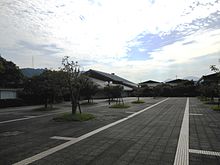


The Kyushu Ceramics Museum (九州陶磁文化館, Kyūshū Toji Bunkakan) is a museum located in Arita town, Saga Prefecture, Japan. It is one of Japan's many museums which are supported by a prefecture.
The museum was built to contribute to the local cultural heritage, and the development of ceramics and pottery culture throughout Kyūshū, southern Japan. A valuable and extensive exhibition of work such as the famous Kanbara Collection of old Imari from Europe of the 17th to 18th centuries, as well as the Shibata Collection covering Arita pottery manufactured from 1603 to 1867.
Collections:
- Shibata Collection
- Kanbara Collection
- Old Ceramics of Kyushu
- Hakuu Collection
- Takatori Collection
- Aoki Ryuzan Works Collection
- Nakazato Hoan Works Collection
See also
References
- "The Kyushu Ceramics Museum". Saga Prefecture Government. Retrieved June 28, 2011.; Saga Prefecture Tourism Division, Guide To SAGA — Tourism & Products. (Brochure.)
- Nussbaum, Louis-Frédéric. (2005). "Museums" in Japan Encyclopedia, pp. 671-673.
External links
[REDACTED] Media related to Kyushu Ceramic Museum at Wikimedia Commons
33°11′20″N 129°53′48″E / 33.188834°N 129.896754°E / 33.188834; 129.896754
This article related to a museum in Japan is a stub. You can help Misplaced Pages by expanding it. |